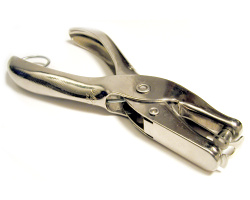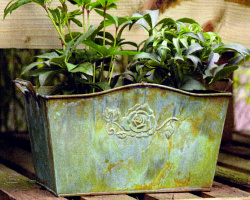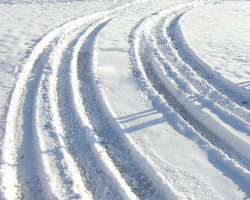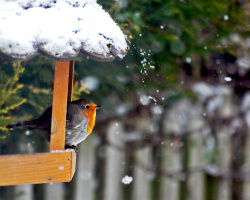Upcycling advice: how to punch out discs?
 We’ve had an email from Kenny that I’m sure some of you will be able to help with:
We’ve had an email from Kenny that I’m sure some of you will be able to help with:
I teach art in Glasgow and I’m trying to find some way of punching disc of various diameters (eg.10mm 15mm 22mm 30mm) out of recycled plastic, fabric, paper etc. to make jewellery. Any suggestions?
The ring-binder size metal ones, like one in the picture, work fine for small circles, but only small discs about 5mm in diameter. I tried using fancier shaped/bigger hole punches with thin plastic but because the ones I had were designed for thick paper/card, the plastic kept gumming them up. Alison Bailey Smith has more luck than me with that sort of thing though and recommends a particular brand of hole punch – X Cut.
Are there any alternatives to using punches? What are the options for bigger circles? Anything quicker/more accurate than just cutting them out with scissors?
Punching holes in fabric other than felt (and the like) may cause a fraying problem, which might ruin/reduce the lifespan of the garment. Any ways around that or other advice?



 As I
As I  Compared to our old tiny yard, we’ve got a pretty big garden now but not that many flower beds – and the previous owners hinted that the beds we have got aren’t that deep (even though some of them are already raised) because the entire garden is built on, essentially, a cliff face. The rock is handy as it stops our house from sliding down the hill into the beck but it means my root veg will have to grow in containers instead.
Compared to our old tiny yard, we’ve got a pretty big garden now but not that many flower beds – and the previous owners hinted that the beds we have got aren’t that deep (even though some of them are already raised) because the entire garden is built on, essentially, a cliff face. The rock is handy as it stops our house from sliding down the hill into the beck but it means my root veg will have to grow in containers instead. Like yesterday’s mince pie case post, this one is also a little late in the season – but it’s only recently that I’ve started hearing about this stuff and apparently we’re getting some more snow this week anyway.
Like yesterday’s mince pie case post, this one is also a little late in the season – but it’s only recently that I’ve started hearing about this stuff and apparently we’re getting some more snow this week anyway. It’s been snowy here for three weeks now and we’re making sure there is always a stock of seeds & nuts available for our local wildlife population. We know that it can be dangerous feeding wildlife too regularly – they become reliant on you and “forget” to find their own food supply, which is a problem if you move away/go away – but for the time being, while their food supply is under a chilly blanket, we’re helping out.
It’s been snowy here for three weeks now and we’re making sure there is always a stock of seeds & nuts available for our local wildlife population. We know that it can be dangerous feeding wildlife too regularly – they become reliant on you and “forget” to find their own food supply, which is a problem if you move away/go away – but for the time being, while their food supply is under a chilly blanket, we’re helping out.














